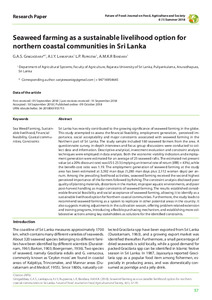| dc.date.accessioned | 2018-10-16T12:35:23Z | |
| dc.date.available | 2018-10-16T12:35:23Z | |
| dc.date.issued | 2018-10-09 | |
| dc.identifier.issn | 2197-411X | |
| dc.identifier.uri | urn:nbn:de:hebis:34-2018061955715 | |
| dc.identifier.uri | http://hdl.handle.net/123456789/2018061955715 | |
| dc.language.iso | eng | |
| dc.publisher | Section Specialized Partnerships in Sustainable Food Systems and Food Sovereignty at the University of Kassel, Germany and Federation of German Scientists (VDW) | ger |
| dc.rights | Urheberrechtlich geschützt | |
| dc.rights.uri | https://rightsstatements.org/page/InC/1.0/ | |
| dc.subject | Sea Weed Farming | eng |
| dc.subject | Sustainable livelihood | eng |
| dc.subject | Financial feasibility | eng |
| dc.subject | Coastal communities | eng |
| dc.subject | Constraints | eng |
| dc.subject.ddc | 630 | |
| dc.title | Seaweed farming as a sustainable livelihood option for northern coastal communities in Sri Lanka | eng |
| dc.type | Aufsatz | |
| dcterms.abstract | Sri Lanka has recently contributed to the growing significance of seaweed farming in the globe. This study attempted to assess the financial feasibility, employment generation, perceived importance, social acceptability and major constraints associated with seaweed farming in the Northern part of Sri Lanka. The study sample included 160 seaweed farmers from the area. A questionnaire survey, in-depth interviews and focus group discussions were conducted to collect data and information. Descriptive analytical, investment evaluation and constraint analysis techniques were employed in data analysis. Both the economic viability indicators and employment generation were estimated for an average of 25 seaweed rafts. The estimated net present value (at a 20% discount rate) was US $ 253 (implying an Internal rate of return [IRR] = 43%), while the benefit-cost ratio was 1.19. The employment generation of seaweed farming at the study area has been estimated at 3,392 man days (1,280 man days plus 2,112 woman days) per annum. Among the prevailing livelihood activities, seaweed farming received the second highest perceived importance of the farmers followed by fishing. The constraint analysis disclosed poor quality of planting materials, distortions in the market, improper aquatic environments, and poor post-harvest handling as major constraints of seaweed farming. The results established considerable financial feasibility and social acceptance of seaweed farming, allowing it to identify as a sustainable livelihood option for Northern coastal communities. Furthermore, the study leads to recommend seaweed farming as a system to replicate in other potential areas in the country. It also suggests making adjustments in the cultivation season, offering problem related extension and training programs, introducing a flexible purchasing mechanism, and establishing more collaborative actions among key stakeholders as solutions for the identified constraints. | eng |
| dcterms.accessRights | open access | |
| dcterms.bibliographicCitation | In: Future of Food: Journal on Food, Agriculture and Society. Witzenhausen : University of Kassel, Specialized Partnerships in Sustainable Food Systems and Food Sovereignty. - Vol. 6, No. 1 (2018), S. 57-70 | |
| dcterms.creator | Ginigaddara, G.A.S. | |
| dcterms.creator | Lankapura, A.I.Y. | |
| dcterms.creator | Rupasena, L.P. | |
| dcterms.creator | Bandara, A.M.K.R. | |

